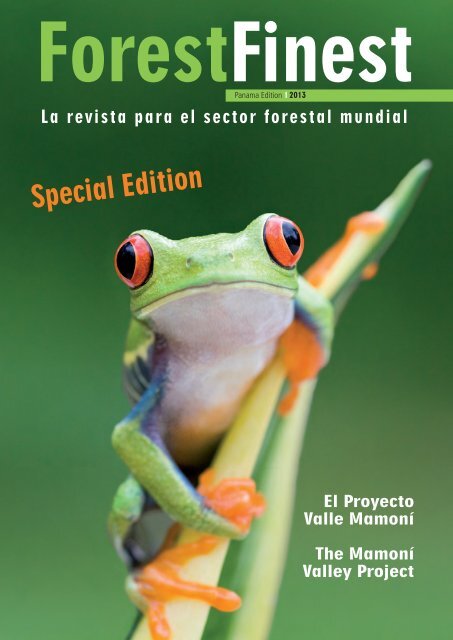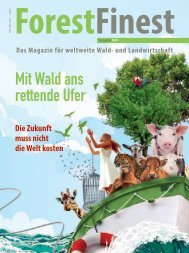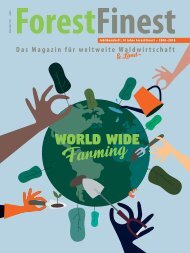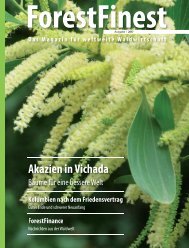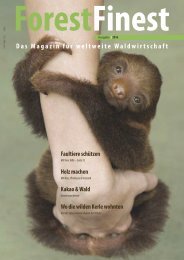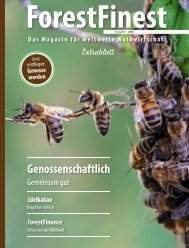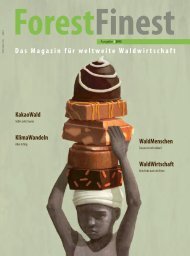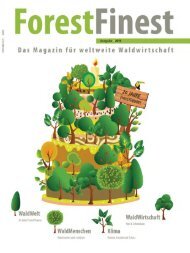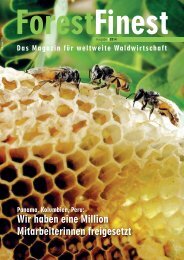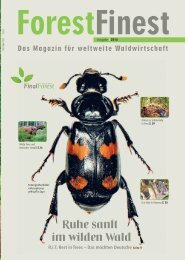ForestFinest: Sonder-Magazin (Englisch und Spanisch)
El Proyecto Valle Mamoní / The Mamoní Valley Project
El Proyecto Valle Mamoní / The Mamoní Valley Project
Create successful ePaper yourself
Turn your PDF publications into a flip-book with our unique Google optimized e-Paper software.
<strong>ForestFinest</strong><br />
Panama Edition 1 2013<br />
La revista para el sector forestal m<strong>und</strong>ial<br />
Special Edition<br />
El Proyecto<br />
Valle Mamoní<br />
The Mamoní<br />
Valley Project
Prefacio Foreword<br />
Los gritos de la naturaleza<br />
The Cries of Nature<br />
La reconocida especialista Jane Goodall ha identificado cerca de<br />
20 llamadas diferentes que los chimpancés usan para comunicarse.<br />
El "panthoot" se utiliza para hacer contacto con la tropa<br />
desde la distancia, de hecho, todas las especies de la tierra interactúan<br />
y se comunican con el fin de garantizar su conservación y supervivencia.<br />
El diálogo de la naturaleza está fuera de la capacidad<br />
de entendimiento de un ser humano. En el bosque, por ejemplo,<br />
árboles advierten mutuamente de los ataques de insectos y hongos<br />
utilizando su red de raíces subterráneas, del mismo modo esta<br />
misma red es capaz de proporcionar los nutrientes necesarios<br />
para que un árbol enfermo pueda sobrevivir.<br />
¿Podemos escuchar los mensajes de la naturaleza? Teniendo en<br />
cuenta la forma en que tratamos a nuestro planeta, parece que<br />
somos sordos y ciegos ante sus gritos de auxilio. Si no es así,<br />
¿cómo se justifica la eliminación de miles de metros cuadrados<br />
de bosques y docenas de especies todos los días?<br />
Nosotros junto con Earth Train y muchas personas dedicadas,<br />
tenemos proyectos dedicados a educar nuestros oídos para<br />
escuchar los gritos de la naturaleza. El Valle Mamoní es un lugar<br />
muy importante en América Central, es aquí donde podemos<br />
aprender a escuchar.<br />
The renowned specialist Jane Goodall has identified nearly 20<br />
different calls that chimpanzees use to communicate in the wild.<br />
The “panthoot” is used to make contact with the troop from a<br />
distance. In fact, every species on Earth interacts and communicates<br />
in order to ensure its preservation and survival. Nature’s dialogue<br />
extends beyond human’s capacity to hear. In the forest, for<br />
example, trees warn each other of insect and fungal attacks using<br />
their network of subterranean roots. Likewise, using this same<br />
network, they are able to provide the nutrients necessary for a<br />
sick tree to survive.<br />
Can we hear Nature’s messages? Taking into consideration the<br />
way we treat our planet, it seems we are both deaf and blind to<br />
her cries for help. If not, then how do we justify the elimination<br />
of thousands of square meters of nature and dozens of species<br />
every day!<br />
Together with Earth Train and many talented people, our projects<br />
are dedicated to training our ears to hear the cries of Nature.<br />
Mamoní Valley is a very important<br />
place in Central America. It is here<br />
that we can learn to listen.<br />
Harry Assenmacher, CEO ForestFinance<br />
Editor <strong>ForestFinest</strong><br />
Contenido_Content<br />
2 Prefacio_Foreword<br />
3 El Proyecto Valle Mamoní_The Mamoní Valley<br />
Project<br />
Fotos_Photos: www.shutterstock.com (5)<br />
6 Entrevista_Interview<br />
con_with Harry Assenmacher (CEO ForestFinance Group),<br />
Petra Kollmannsberger (CEO ForestFinance Panama), Nathan Gray<br />
(Co-executive Director, Earth Train)<br />
Pie de imprenta_Imprint <strong>ForestFinest</strong><br />
Panama Special Edition N°. 1/2013_Edición Especial Panamá n°1/2013<br />
Editor a cargo_Editor in charge: Forest Finance Service GmbH, Harry Assenmacher,<br />
CEO, HRB 13610, AG Bonn, Eifelstraße 20, 53119 Bonn, Germany/Alemania<br />
Editores_Editors: Leonie Ahrens, Christine Sommer-Guist, Harry Assenmacher<br />
Los empleados involucrados en esta edición_ Employees involved in this edition:<br />
Carina Weber, Petra Kollmannsberger, Earth Train<br />
Diseño y producción_Design and production: SOKO-Layout, Marc Venner<br />
Fotografía de la portada_Cover photo: photos.com<br />
Contacto editorial_Editorial contact: redaktion@forestfinance.de, Forest Finance<br />
Service GmbH, Eifelstr. 20, 53119 Bonn, Germany_Alemania, Tel.: 0049 228/943 7780<br />
Impresión_Print: 3 000 Copias_Copies, Z.B.! Kunstdruck mbH, Colonia_Cologne, Alemania_Germany,<br />
impreso en papel reciclado 100%_printed on 100% recycled paper<br />
climate neutral<br />
production<br />
COB-47826/2013<br />
2 FF www.forestfinance.com
Mamoní: el proyecto the project<br />
El Proyecto Valle Mamoní: ForestFinance<br />
y Earth Train salvan a un hotspot importante<br />
de biodiversidad en el corazón<br />
verde de Panamá<br />
Harry Assenmacher, CEO ForestFinance, Petra Kollmannsberger,<br />
CEO ForestFinance Panama, Lider Sucre, codirector ejecutivo<br />
de EarthTrain y líder ambiental y naturalista respectado,<br />
aquí con Nathan Gray, codirector ejecutivo de EarthTrain,<br />
en el Valle Mamoní. Harry Assenmacher, CEO ForestFinance,<br />
Petra Kollmannsberger, CEO ForestFinance Panama, Líder<br />
Sucre, Co-Executive Director for Earth Train and a respected<br />
environmental leader and naturalist, here with Nathan Gray,<br />
Co-Director of Earth Train, in Mamoní Valley.<br />
The Mamoní Valley Project:<br />
ForestFinance and Earth Train<br />
save a key biodiversity hotspot<br />
in Panama’s green heart<br />
La cuenca superior del río Mamoní amortigua el Bosque<br />
Nacional Chagres, el borde suroccidental de Guna Yala,<br />
cual es territorio semiautónomo de los Guna. Estos<br />
bosques, que albergan el jaguar y la gran águila arpía,<br />
caen dentro de dos de los hotspots de biodiversidad<br />
reconocidos internacionalmente. La cuenca superior<br />
Mamoní y sus seis principales afluentes que se encuentran<br />
a sólo 40 kilómetros este de la ciudad de Panamá,<br />
crean una fuente vital de agua potable en la provincia<br />
de Panamá.<br />
Sin embargo, en 2004 Earth Train y Rainforest Capital, ambos<br />
socios de ForestFinance, reconocieron que la cuenca superior del<br />
río Mamoní estaba en peligro; impulsada principalmente por<br />
hacendados poco presentes, la tala y quema de selva primaria y<br />
The upper Río Mamoní watershed buffers the Chagres<br />
National Forest and the southwestern edge of Guna<br />
Yala, the semi-autonomous territory of the Guna. These<br />
forests, home to the jaguar and the great Harpy Eagle,<br />
fall within two of the internationally recognized biodiversity<br />
hotspots. The upper Mamoní watershed and its<br />
six major tributaries, located only 25 miles to the east<br />
of Panama City, are a vital source of potable water in<br />
the rapidly developing Province of Panamá.<br />
However, in 2004, Earth Train and Rainforest Capital, both partners<br />
of ForestFinance, recognized that the watershed of the upper<br />
Río Mamoní was in jeopardy. Driven primarily by absentee ranchers,<br />
the cutting and burning of primary forest and the degradation of<br />
www.forestfinance.com<br />
FF3
Mamoní: el proyecto the project<br />
Jane Goodall ha dedicado su vida al estudio del<br />
comportamiento de los chimpancés en África y a<br />
educar y promover estilos de vida más sostenibles en<br />
todo el planeta. Ella es f<strong>und</strong>adora del Instituto Jane<br />
Goodall : la Primera Conferencia de Liderazgo de<br />
Bosques Tropicales de América Latina y El Caribe para<br />
Roots & Shoots de Jane Goodall tuvo lugar en el<br />
centro Mamoní en noviembre del 2011.<br />
Jane Goodall, the fo<strong>und</strong>er of the Jane Goodall Institute,<br />
is considered to be the world's foremost expert<br />
on chimpanzees and she has worked extensively on<br />
conservation and animal welfare issues. The first Latin<br />
America and The Caribbean Rainforest Leadership<br />
Conference for Jane Goodall’s Roots & Shoots was<br />
hosted by Earth Train at Centro Mamoní in November<br />
2011.<br />
la degradación del suelo por pastoreo excesivo amenazaban<br />
con cambiar el microclima húmedo de la zona y aumentar el<br />
potencial destructivo de las in<strong>und</strong>aciones del río. En conjunto<br />
con organizaciones de base (grassroots) y los líderes nacionales,<br />
crearon la Reserva Valle Mamoní. Ahora, ForestFinance está<br />
trabajando con Earth Train y Rainforest Capital para expandir<br />
en gran medida la restauración ecológica y el desarrollo<br />
sostenible de la Reserva.<br />
En 2013 ForestFinance se hizo cargo de la gestión de las actividades<br />
de reforestación en la Reserva e invirtió más en el desarrollo<br />
sostenible. La creación de oportunidades de empleo a<br />
largo plazo beneficiará a alrededor de 400 personas que viven<br />
en el área. Con más de 17 años de experiencia en "crear bosques”,<br />
nos especializamos en el financiamiento, desarrollo,<br />
mantenimiento de proyectos forestales, agro-forestales y<br />
proyectos de captura y almacenamiento de carbono. Hemos<br />
demostrado que la reforestación y la protección de los bosques,<br />
así como una gestión integrada y sostenible de los bosques<br />
naturales y las plantaciones, pueden asegurar ecosistemas<br />
forestales saludables. En equipo con Earth Train y Rainforest<br />
Capital, ForestFinance está trabajando para crear un<br />
modelo sobresaliente de la gestión del capital natural y la educación<br />
ambiental en el Valle Mamoní.<br />
soil by overgrazing were threatening the area's moist microclimate<br />
and increasing the destructiveness of river floods. Working<br />
with grassroots and national leaders, they created the Mamoní<br />
Valley Preserve. Now, ForestFinance is working with Earth Train<br />
and Rainforest Capital to greatly expand the ecological restoration<br />
and sustainable development work of the Preserve.<br />
In 2013 ForestFinance took over the management of reforestation<br />
activities in the Preserve while investing more in sustainable<br />
development. The creation of long-term job opportunities<br />
will benefit aro<strong>und</strong> 400 people living in the area.<br />
With over 17 years of experience ‘building forests’, we specialize<br />
in financing, developing and maintaining of forests, agro-forestry<br />
and carbon forest projects. We have demonstrated how<br />
reforestation and forest protection - as well as an integrated and<br />
sustainable management of natural and plantation forests - can<br />
ensure healthy forest ecosystems. In team with Earth Train and<br />
Rainforest Capital, ForestFinance is working to create an outstanding<br />
model of natural capital management and environmental<br />
education in the Mamoní Valley.<br />
El Centro de Earth Train para el<br />
Liderazgo Biocultural (Centro<br />
Mamoní ) en el borde del bosque,<br />
cuenta con amplio espacio para<br />
alojamiento y reuniones - todo ello<br />
controlado con un micro sistema<br />
hidroeléctrico y conectado al m<strong>und</strong>o<br />
a través de un servicio de banda<br />
ancha por satélite.<br />
Earth Train’s Center for Biocultural<br />
Leadership (Centro Mamoní) at<br />
forest’s edge, offers ample space for<br />
housing and meeting – all<br />
powered with a micro hydro-electric<br />
system and linked to the world<br />
through a broadband satellite<br />
service.<br />
4 FF www.forestfinance.com
Mamoní: el proyecto the project<br />
Festival de Liderazgo Biocultural con Jane Goodall<br />
en Panamá del 13 al 15 de noviembre de 2013<br />
Este año ForestFinance patrocina el “Festival de Liderazgo Biocultural<br />
con Jane Goodall” de Earth Train. El objetivo de este<br />
festival multifacético es presentar el trabajo que Earth Train y<br />
sus organizaciones asociadas están realizando “hacia el fomento<br />
de un nuevo tipo de liderazgo dirigido a la creación de una<br />
civilización en armonía con la naturaleza, enriquecida con la<br />
diversidad biológica y cultural”. El evento de este año complementa<br />
la Primera Conferencia de Liderazgo de Bosques Tropicales<br />
de América Latina y El Caribe que se dirigió hacia jóvenes y<br />
mentores de Roots & Shoots de Jane Goodall; organizada por<br />
Earth Train, patrocinada por ForestFinance en el 2011 para Jane<br />
Goodall y 40 líderes de Roots & Shoots de 12 países.<br />
Spotlighting Biocultural Leadership with Jane<br />
Goodall in Panama, November 13th to 15th, 2013<br />
This year ForestFinance is sponsoring Earth Trains’ Spotlight<br />
on Biocultural Leadership with Jane Goodall. The goal of this<br />
multifaceted program is to introduce the work Earth Train and<br />
their partner organizations are doing “toward fostering a new<br />
kind of leadership aimed at creating civilization in harmony<br />
with nature enriched with biological and cultural diversity”.<br />
This year’s event builds on the first Latin American/Caribbean<br />
Rainforest Leadership Conference for Jane Goodall´s Roots &<br />
Shoots Youth and Mentors produced by<br />
Earth Train in 2011 and sponsored by<br />
ForestFinance for Jane Goodall<br />
and 40 Roots & Shoots leaders<br />
from twelve countries.<br />
La reforestación en el Valle del Mamoní se ha<br />
enfocado en las especies de árboles nativos.<br />
The Mamoní plantation has been focused<br />
primarily on the planting of native tree species.<br />
www.forestfinance.com FF 5
En la conversación In conversation<br />
3 Voces _ 3 Voices<br />
¿Qué hace tan especial la reserva Valle Mamoní?<br />
Harry Assenmacher, director ejecutivo de Forest-<br />
Finance; empresa alemana de inversión forestal<br />
sostenible, Petra Kollmannsberger, directora ejecutiva<br />
de ForestFinance en Panamá, y Nathan Gray, co-director<br />
ejecutivo de la ONG ambiental Earth Train,<br />
explican en una entrevista de 3 voces cómo llegaron<br />
a trabajar juntos en la Reserva Valle Mamoní.<br />
What makes Mamoní Valley so special? Harry<br />
Assenmacher, CEO and fo<strong>und</strong>er of the German sustainable<br />
forest investment company ForestFinance, Petra<br />
Kollmannsberger, the company’s CEO in Panama,<br />
and Nathan Gray, co-director of the environmental<br />
NGO Earth Train, explain in a 3-voices interview how<br />
they came to work together on the Mamoní Valley<br />
Preserve.<br />
Harry, Petra y Nathan (de izquierda a derecha) están trabajando juntos para preservar<br />
el Valle Mamoní, ubicado en la ecoregión Chocó-Darién-Manabí, una de<br />
las 20 áreas de mayor prioridad de conservación en el planeta.<br />
¿Qué hace la Reserva del Valle Mamoní un lugar ideal tanto para<br />
una ONG ambiental como para una empresa forestal sostenible?<br />
Harry Assenmacher (HA): Es uno de estos raros lugares que combinan<br />
una biodiversidad muy alta y la proximidad a un “hotspot” de la civilización<br />
moderna. Por tanto, consiste en un reto para una ONG, pero también<br />
para una empresa dedicada a la sostenibilidad como ForestFinance,<br />
quien trabaja allí, no solo para crear un nuevo "Parque Nacional" pero<br />
también para desarrollar un sistema económico sostenible que salve a la<br />
vida silvestre en vez de destruirla.<br />
Petra Kollmannsberger (PK): Es una de las áreas más preciosas en el<br />
corredor biológico Mesoaméricano, que se extiende desde el sureste de<br />
México y atraviesa la mayor parte de Centroamérica, conectando varios<br />
parques, refugios, bosques nacionales y privados. Como miembro f<strong>und</strong>ador<br />
de la Asociación para la Biodiversidad Mesoamérica; una plataforma<br />
de organizaciones internacionales en Centroamérica trabajando por la<br />
biodiversidad, la sostenibilidad y el cambio climático; el objetivo de ForestFinance<br />
es hacer del Valle Mamoní una iniciativa de organizaciones<br />
locales y de propietarios forestales privados para así tener un impacto real<br />
en la zona, mientras creamos fuentes locales de empleo.<br />
Harry, Petra and Nathan (left to right) work together to preserve the Mamoní<br />
Valley, which is located in the ecoregion Chocó-Darién-Manabí, one of the 20<br />
high priority conservation areas on Earth.<br />
Fotos_Photos: ForestFinance/roadtripnation.com<br />
What makes the Mamoní Valley Preserve an ideal place for both an<br />
environmental NGO and a sustainable forestry company?<br />
Harry Assenmacher (HA): It is one of the very rare places combining an<br />
incredibly high biodiversity and the proximity of a "hotspot" of modern civilization.<br />
It is therefore a challenge for an NGO, but as well for a company<br />
dedicated to sustainability, like ForestFinance that operates there,<br />
to create a new "National Park" and also to establish a sustainable<br />
economic system that saves wildlife instead of destroying<br />
it.<br />
Petra Kollmannsberger (PK): It is one of the most precious<br />
areas within the biological corridor of Mesoamerica,<br />
stretching from Mexico southeastward through most<br />
of Central America, connecting several national<br />
parks, national and private nature<br />
refuges and private wild<br />
lands. As a fo<strong>und</strong>ing member<br />
of the Biodiversity<br />
Nathan Gray (NG): ¿Dónde más en el planeta Tierra existe un radio de<br />
cincuenta kilómetros ofreciendo tanto? Uno se encuentra allí cerca de los<br />
dos mayores océanos, cruzando por un corredor de biodiversidad que conecta<br />
unos dos millones de hectáreas de selva primaria al lado del Canal<br />
6 FF www.forestfinance.com
En la conversación In conversation<br />
de Panamá y de la capital de una de las economías más<br />
florecientes del continente americano, mientras comprende<br />
una variedad de culturas. En los últimos trece<br />
años, ha demostrado ser el lugar ideal para<br />
aprender más sobre la restauración ecológica, el<br />
manejo de cuencas y el desarrollo económico basado<br />
en el capital natural. Además, teniendo en<br />
cuenta nuestro compromiso de influir positivamente<br />
en las políticas públicas, la accesibilidad<br />
del Valle ofrece una ventaja clave.<br />
¿Cuáles son los principales desafíos de la<br />
operación?<br />
HA: Hay un desafio técnico en la búsqueda de un<br />
equilibrio entre la conservación de la naturaleza<br />
y el establecimiento de una operación económica<br />
sostenible mediante la reforestación de un bosque<br />
mixto. Debe colaborar con los intereses de la población<br />
local, incluyendo el progreso económico, así como<br />
"el interés de la naturaleza" en ser "salvaje" y virgen.<br />
Esto puede llevarse a cabo trabajando junto con organizaciones<br />
no gubernamentales. Lo más importante es<br />
encontrar compromisos útiles y aceptados que unan la "civilización<br />
moderna" representada por las empresas, los políticos y los<br />
intereses "metafísicos" del Valle Mamoní. Es necesario concientizar sobre<br />
los derechos de la naturaleza: hay que defenderlos y equilibrarlos con<br />
los derechos humanos.<br />
PK: Panamá es un país en pleno crecimiento, pero necesitamos un desarrollo<br />
más sostenible y más apoyo de las políticas públicas. Actualmente,<br />
el sector forestal no recibe suficiente apoyo e incentivos para seguir<br />
creciendo, sin embargo podría jugar un papel importante en las zonas rurales<br />
donde las oportunidades de empleo y las inversiones son escasas.<br />
El sector de la reforestación ha creado cerca de 10,000 puestos de trabajo<br />
en los últimos años en Panamá; casi tanto como el Canal.<br />
El peligro sobre los bosques primarios aquí es muy alto y las autoridades<br />
todavía están luchando para controlar la tala ilegal. Una silvicultura ecológica<br />
certificada y el apoyo de las comunidades locales pueden ayudar<br />
con esos desafíos. Esperamos encontrar un apoyo pronto para crear un<br />
sector con un modelo de ingresos alternativos que sirvan a las personas<br />
que viven en áreas ecologicamente amenazadas.<br />
NG: Como varios estudios lo han demostrado, la mera designación de<br />
una zona como "protegida" atrae amenazas que de otro modo tardarían<br />
más en materializarse. En el Valle Mamoní, ubicado cerca<br />
de un área metropolitana, las amenazas llegan con la compra, por<br />
los promotores, de los terrenos alrededor o incluso con el intento<br />
de invadir áreas protegidas. A menudo,<br />
los locales se sienten frustrados<br />
por no poder usar áreas adyacentes,<br />
que fueron declaradas inaccesibles<br />
para la caza y la tala de árboles.<br />
Por eso estamos comprometidos<br />
a definir cómo una<br />
reserva puede servir<br />
de recurso para la<br />
restauración, la conservación<br />
y el desarrollo<br />
sostenible de la<br />
comunidad.<br />
Partnership Mesoamerica, an international organizations<br />
platform in Central America concerned<br />
with biodiversity, sustainability and climate<br />
change, it is our company’s goal to make the<br />
Mamoní Valley Preserve an initiative involving<br />
neighboring organizations and private<br />
forest owners in order to have a real impact<br />
on the area while creating local jobs.<br />
Nathan Gray (NG): Where else on Planet<br />
Earth can a fifty kilometer radius deliver so<br />
much? You’re close to the world’s greatest<br />
oceans; crossing a corridor of biodiversity<br />
that links two million hectares of primary<br />
forest, reaching the Panamá Canal and the<br />
capital city of one of the fastest growing economies<br />
in the Americas while encompassing<br />
a diversity of cultures. In our experience over<br />
the last thirteen years, this has proven to be the<br />
ideal place for learning about ecological restoration,<br />
watershed management and economic development<br />
based on natural capital. Also, given our commitment<br />
to positively influencing public policy, the accessibility<br />
of the Preserve offers a key advantage.<br />
What are the major challenges of the operation?<br />
HA: There is a technical challenge in finding the right balance between preserving<br />
nature and not interfering in its processes but at the same time to<br />
establish an economically sustainable operation. We want to achieve this<br />
by reforesting a mixed-tree-species forest that serves both the locals’ interest<br />
− including economic progress - and nature’s interest to remain "wild"<br />
and untouched. This dilemma has to be solved together with governmental<br />
organizations. The most important challenge is to find useful and accepted<br />
compromises between "modern civilization" represented by companies<br />
and politics and the "metaphysical" interests of the Mamoní Valley.<br />
It is necessary to sharpen awareness of the fact that nature has rights which<br />
have to be defended and put in balance with our human rights.<br />
PK: Panama is a booming country. But we need more sustainable development<br />
and public policies to support this progress. At the moment, the<br />
forestry sector does not receive enough support and incentives to keep on<br />
growing, but it could be a significant player in rural areas where job opportunities<br />
and investment are scarce. The reforestation sector in Panama<br />
has created nearly 10,000 jobs over the last years, almost as much as the<br />
Canal.<br />
The pressure on primary forest in this country is very high and authorities<br />
are still struggling to control illegal logging. Certified ecological forestry and<br />
support of the local communities can help to tackle those challenges. We<br />
hope to find support soon, in order to create a strong sector and alternative<br />
income models for people living in ecologically endangered areas.<br />
NG: As various studies have shown, the mere designation of an area as<br />
“protected” attracts threats that would otherwise be slow to materialize.<br />
In the Mamoní Valley, close to major metropolitan areas, the threats include<br />
the efforts of real estate speculators to buy up the surro<strong>und</strong>ings or even<br />
attempt to carve out sections of the protected areas. Locals often become<br />
resentful at having adjacent areas declared off limits to hunting and logging.<br />
That's why we are committed to modeling how a reserve can serve<br />
as resource for restoration, conservation and sustainable community development.<br />
www.forestfinance.com FF 7
Your eco-investment:<br />
reap the green profits from<br />
afforestation in Panama<br />
By purchasing a TreeSavingsPlan, we plant 12 native trees per year in Panama.<br />
In Darién and soon also in the Mamoní Valley.<br />
© Andres Espinosa<br />
Mamoni Valley<br />
© google 2013<br />
TreeSavingsPlan<br />
San Blas<br />
Colon<br />
The advantages of this sustainable product<br />
from Panama:<br />
Chiriquí<br />
Veraguas<br />
Coclé<br />
Los Santos<br />
Panama<br />
Darien<br />
- aprox. return of 4 to 9 per cent<br />
- 1 tree per month<br />
- sustainable afforestation for timber production<br />
- long term renaturation and conservation of Panamanian mixed forests<br />
- creation of new employment in rural areas<br />
- only 45 USD per month or 485 USD per year<br />
www.forestfinance.com<br />
8 FF www.forestfinance.de


